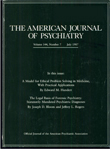Reversed neurovegetative symptoms of depression: a community study of Ontario
Abstract
OBJECTIVE: Most research on depression with reversed neurovegetative features (hypersomnia, hyperphagia, and weight gain) has been based on site-specific clinic-based samples. The goal of this study was to delineate the epidemiology of reversed symptoms in a large community sample and to use other symptom patterns for comparison. METHOD: Interviewers assessed 8,116 subjects across Ontario, aged 15-64 years, by using the World Health Organization Composite International Diagnostic Interview. Individuals who met the DSM-III-R criteria for major depression, current or lifetime, were classified into four groups on the basis of lifetime neurovegetative symptoms: episodes of typical symptoms only, episodes of reversed symptoms only, neither type, or both types (fluctuating-symptom group). The groups were compared on demographic characteristics, comorbidity, disability, and health care utilization. RESULTS: Of the 653 individuals with lifetime major depression, 11.3% had episodes of reversed symptoms only, and another 5.8% were classified as fluctuating. Most of the differences among the four groups were due to the unique characteristics of the groups with neither type of episode or a fluctuating pattern; individuals who had experienced only reversed symptoms were remarkably similar to those who had had only typical symptoms. The fluctuating-symptom group had high rates of comorbidity, substance abuse, and health care utilization. CONCLUSIONS: Several popular beliefs about depression with reversed features did not hold true for this community sample. Identifying individuals who fluctuate between reversed and typical episodes may be important in studies of major depression, in particular when reversed neurovegetative symptoms are a consideration.



